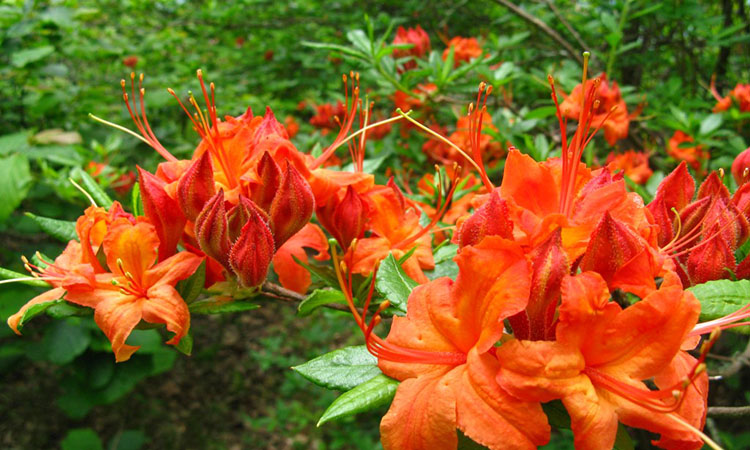Last Updated on May 9, 2023
There’s something to the old adage that April showers bring May flowers. In the mountains of Western North Carolina, that means our spring erupts with early white, red, and yellow blooms each year. However, spring isn’t the only time to see beautiful blooms, and wildflower season is not over yet.
The Blue Ridge Mountains rise above our communities from 1,200 to more than 6,000 feet above sea level. Because of the wide range in elevations, wildflowers appear weeks and weeks apart as you travel from base to peak. In July, it is the perfect season to spot turk’s cap lilies, common milkweed, wild bergamot, and more.
Here’s how to search high and low get your flower fix and find summer wildflowers in the mountains.
Search high along the Blue Ridge Parkway and mountain peaks for summer wildflowers
Searching high and low is a breeze in WNC! Along the scenic and easily accessible Blue Ridge Parkway, Mount Mitchell and Craggy Gardens offer places in the mountains to see summer wildflowers without even getting out of your car.
Wildflowers near Mount Mitchell
Located near Burnsville, Mount Mitchell is the highest peak in eastern mainland North America (6,684 feet in elevation). Within a short trail walk or hike from the accessible observation deck, you can easily stroll alongside many of the hundreds of flower species dotting the high-elevation spruce-fir forests. July brings mountain ash, a member of the rose family that blooms in bunches of white flowers.
Wildflowers near Craggy Gardens
The Craggy Gardens trail, located at milepost 361.2 on the Parkway, offers incredible sunset views, making it a popular destination. It’s also recognized by the state of North Carolina as a National Heritage Area. In July, you’re sure to have some privacy among the twisted rhododendron vines and high-elevation mosses.
Wildflowers near Pisgah National Forest
Also topping 6,000 feet in elevation, Roan Mountain within Pisgah National Forest is famous for its wildflowers and rare plant species. Most striking is the Catawba rhododendron, which bursts with pink and lavender blooms well into late June and early July. Pink Beds, near Sliding Rock, loops through a number of pink wildflowers, including mountain laurel and rhododendron, blanketing the relatively flat valley.
Wildflowers near Great Smoky Mountains National Park
Did you know that Great Smoky Mountains National Park is a world-renowned nature preserve? The park has more than 1,660 species of flowering plants alone—more than any other national park on the continent! The lower elevations peak in bloom around April. But you can still find flowers at higher elevations well into the start of summer. For a great wildflower walk within walking distance of easy parking, try the easy, three-mile, riverside Oconaluftee River Trail.
Search low at area botanical gardens for summer mountain wildflowers
There’s no need to venture too far into the forests and mountains to see native summer wildflowers in bloom. No matter the time of year, it’s easy to enjoy native and non-native plant species at local botanical gardens.
Wildflowers in the Botanical Gardens at Asheville
Walkable from downtown, the Botanical Gardens at Asheville are located adjacent to the UNC Asheville campus. Stroll the half-mile loop to see dozens of plants native to the Southern Appalachian Mountains. Although their peak flower season runs April through mid-May, there is almost always something blooming in this well-kept, 10-acre garden. Through the summer, enjoy the blooms of native berry bushes and goldenrods.
Wildflowers in North Carolina Arboretum
The North Carolina Arboretum is located south of downtown Asheville in the Bent Creek community and immediately accessible from the Blue Ridge Parkway. Their 65 acres of cultivated gardens and groomed trails feature some of the most beautiful, botanically-diverse plants in the region. In addition, the Arboretum hosts plenty of pollinators and a permanent bonsai exhibit. Their National Native Azalea Collection, part of the Nationally Accredited Plant Collections™ and pictured above, is “a woodland garden with azaleas representing nearly every species native to the U.S., along with many natural hybrids and selections.”
Live a life in bloom in Asheville, NC
With a population of 90,000+, Asheville is the largest city in both Buncombe County and Western North Carolina. Asheville serves as the area’s economic and cultural nerve center in many ways. It’s a hub for education, healthcare, local arts and crafts, entertainment, night life, and innovative food and drink. Throughout the city, Asheville’s neighborhoods are interconnected, not just by our mountains and rivers, but also by our local community centers—those intentionally created and those that have grown organically.
Does that sound like the perfect lifestyle for you? Find your dream home in Asheville now!




